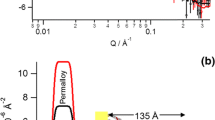Abstract
Protein arrays are used in a wide range of applications. The array described here binds IgG antibodies, produced in rabbit, to gold surfaces via a scaffold protein. The scaffold protein is a fusion of the monomeric E. coli porin outer membrane protein A (OmpA) and the Z domain of Staphylococcus aureus protein A. The OmpA binds to gold surfaces via a cysteine residue in a periplasmic turn and the Z domain binds immunoglobulins via their constant region. Polarised Neutron Reflection is used to probe the structure perpendicular to the gold surface at each stage of the assembly of the arrays. Polarised neutrons are used as this provides a means of achieving extra contrast in samples having a magnetic metal layer under the gold surface. This contrast is attained without resorting to hydrogen/deuterium exchange in the biological layer. Polarised Neutron Reflection allows for the modelling of many and complex layers with good fits. The total thickness of the biological layer immobilised on the gold surface is found to be 187 Å and the layer can thus far be separated into its lipid, protein and solvent parts.





Similar content being viewed by others
Abbreviations
- BME:
-
2-Mercaptoethanol
- DTT:
-
Dithiothreitol
- IgG:
-
Immunoglobulin G
- IMAC:
-
Immobilized metal affinity chromatography
- IPTG:
-
Isopropyl-β-d-thiogalactopyranoside
- OG:
-
n-Octylglucoside
- OmpA:
-
Outer membrane protein A
- OmpAZ:
-
Circularly permuted OmpA with two SpA Z domains fused at the N terminus
- PNR:
-
Polarised Neutron Reflection
- Q:
-
Momentum transfer
- SDS:
-
Sodium dodecyl sulphate
- SLD:
-
Scattering length density
- SpA:
-
Staphylococcus aureus protein A
- TCEP:
-
Tris(2-carboxy-ethyl)phosphine hydrochloride
- thioPEG:
-
Polyethylene glycol with a thiolalkane functional group
References
Bain CD, Troughton EB, Tao Y-T, Evall J, Whitesides GM, Nuzzo RG (1989) Formation of monolayer films by the spontaneous assembly of organic thiols from solution onto gold. J Am Chem Soc 111:321–335
Cisneros DA, Muller DJ, Daud SM, Lakey JH (2006) An approach to prepare membrane proteins for single-molecule imaging. Angew Chem Int Ed 45:3252–3256
Deisenhofer J (1981) Crystallographic refinement and atomic models of a human Fc fragment and its complex with fragment B of protein A from Staphylococcus aureus at 2.9- and 2.8 Å resolution. Biochemistry 20:2361–2370
Dubois LH, Nuzzo RG (1992) Synthesis, structure and properties of model organic surfaces. Annu Rev Phys Chem 43:437–463
Holt SA, Lakey JH, Daud SM, Keegan N (2005) Neutron reflectometry of membrane protein assemblies at the solid/liquid interface. Aust J Chem 58:674–677
Keegan N, Lakey JH, Wright NG (2005) Circular dichroism spectroscopy of folding in a protein monolayer. Angew Chem Int Ed 44:4801–4804
Kienzle PA, Doucet M, McGillivray DJ, O’Donovan KV, Berk NF, Majkrzak CF (2000–2006) GA_refl for simultaneous fitting of reflection data http://www.ncnr.nist.gov/reflpak
Kingsmore SF (2006) Multiplexed protein measurement: technologies and applications of protein and antibody arrays. Nat Rev Drug Discov 5:310–320
Koebink R, Kramer L (1995) Membrane assembly of circularly permuted variants of the E. coli outer membrane protein OmpA. J Mol Biol 250:617–626
Liu C, Xia Z, Czernuszka JT (2007) Design and development of three-dimensional Scaffolds for tissue engineering. Chem Eng Res Des 85:1051–1064
Majkrzak CF (1991) Polarized neutron reflection. Physica B 173:75–88
Majkrzak CF, Berk NF (1999) Inverting neutron reflectivity from layered film structures using polarized beams. Physica B 268:168–174
Nilsson B, Moks T, Jansson B, Abrahmsén L, Elmblad A, Holmgren E, Henrichson C, Jones TA, Ulhen M (1987) A synthetic IgG-binding domain based on Staphylococcal protein A. Protein Eng 1:107–113
Parkin SSP, Deline VR, Hilleke RO, Felcher GP (1990) Unidirectionally biased permalloy: a polarized-neutron-reflection experiment. Phys Rev B 42:10583–10591
Pautsch A, Schulz GE (1998) Structure of the outer membrane protein A transmembrane domain. Nat Struct Biol 5:1013–1017
Penfold J (1991) Data interpretation in specular neutron reflection. In: Linder P, Zemb T (eds) Neutron, X-ray and light scattering. Elsevier, Amsterdam, pp 223–236
Shah DS, Thomas MB, Phillips S, Cisneros DA, Le Brun AP, Holt SA, Lakey JH (2007) Self-assembling layers created by membrane proteins on gold. Biochem Soc Trans 35:522–526
Tashiro M, Montelione GT (1995) Structure of bacterial immunoglobulin-binding domains and their complexes with immunoglobulins. Curr Opin Struct Biol 5:471–481
Terrettaz S, Ulrich W-P, Vogel H, Hong Q, Dover LG, Lakey JH (2002) Stable self-assembly of a protein engineering scaffold on gold surfaces. Protein Sci 11:1917–1925
Terry CJ, Popplewell JF, Swann MJ, Freeman NJ, Fernig DG (2006) Characterisation of membrane mimetics on a dual polarisation interferometer. Biosens Bioelectron 22:627–632
Thomas RK (2004) Neutron Reflection From Liquid Interfaces. Annu Rev Phys Chem 55:391–426
Unwin RD, Evans CA, Whetton AD (2006) Relative quantification in proteomics: new approaches for biochemistry. Trends Biochem Sci 31:473–484
Willmott PR (2004) Deposition of complex multielemental thin films. Prog Surf Sci 76:163–217
Acknowledgments
The authors would like to thank Frank Heinrich for help with preparation of the gold surfaces. The Biotechnology and Biological Sciences Research Council, the Science and Technology Facilities Council and Orla Protein Technologies Ltd funded this work.
The identification of any commercial product or trade name does not imply endorsement or recommendation by the National Institute of Standards and Technology.
Author information
Authors and Affiliations
Corresponding author
Additional information
Advanced neutron scattering and complementary techniques to study biological systems. Contributions from the meetings, ‘‘Neutrons in Biology’’, STFC Rutherford Appleton Laboratory, Didcot, UK, 11–13 July and ‘‘Proteins At Work 2007’’, Perugia, Italy, 28–30 May 2007.
Rights and permissions
About this article
Cite this article
Le Brun, A.P., Holt, S.A., Shah, D.S. et al. Monitoring the assembly of antibody-binding membrane protein arrays using polarised neutron reflection. Eur Biophys J 37, 639–645 (2008). https://doi.org/10.1007/s00249-008-0291-2
Received:
Revised:
Accepted:
Published:
Issue Date:
DOI: https://doi.org/10.1007/s00249-008-0291-2




